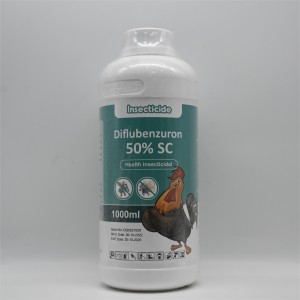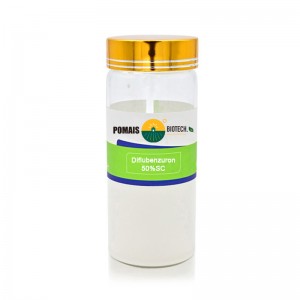Products
Diflubenzuron 50% SC | IRAC 15 IGR for Lepidopteran Larvae
Introduction
What it is. A high-strength diflubenzuron 50% SC engineered for consistent field performance where labels permit. The liquid suspension re-suspends quickly, pumps easily, and supports standardized spray operations without powder dust or complex dissolving steps.
Where it fits. Registration-dependent use across fruit trees, field crops, vegetables, forestry and tea, centered on early-instar Lepidopteran larvae and labeled leafrollers/armyworms/DBM complexes.
How we supply. OEM-ready packs, artwork templates, and auditable documentation (COA/MSDS/TDS) to accelerate distributor onboarding and seasonal launch.
| Field | Value |
|---|---|
| Active / Strength | Diflubenzuron 50% SC |
| IRAC Class / Type | 15 — Benzoylurea chitin synthesis inhibitor (IGR) |
| Activity Profile | Larvicidal/ovicidal, non-knockdown; early instars favored |
| Primary Targets | Labeled Lepidopteran larvae (DBM, armyworms, leafrollers, etc.) |
| Crops / Sites | Fruit trees, field crops, vegetables, forestry/tea (label-dependent) |
| CAS / Formula | 35367-38-5 / C14H9ClF2N2O2 |
| Documentation | COA / MSDS (SDS) / TDS |
| Shelf Life | 2 years (standard storage; see label/SDS) |
Mode of Action
How it works. Diflubenzuron is a benzoylurea insect growth regulator (IGR) that inhibits chitin synthesis in the insect cuticle. Larvae are unable to form a normal exoskeleton at molt, leading to lethal deformities and failure to emerge correctly.
Operational reality. It is larvicidal/ovicidal rather than knockdown; performance is strongest on egg hatch to early instars. Direct adult effects are limited. To maintain long-term efficacy, design rotations with different IRAC groups per label and program design.
Target Pests & Use Areas
Primary targets. Labeled Lepidopteran larvae such as diamondback moth, beet/true armyworms, Spodoptera litura, leafrollers, fruit moth complexes, and other listed species.
Use areas. Apples/pears/peaches/citrus, corn/wheat/rice/cotton/peanut, brassicas/solanaceae/melons, tea, and managed forestry/timber where permitted. Final crop/pest lists, intervals, and restrictions are governed by your local label.








Using Method
20% diflubenzuron suspension is suitable for conventional sprays and low-volume sprays, and can also be used for aircraft operations. When using, shake the liquid well and dilute it with water to the usage concentration, and prepare it into a milky suspension for use.
|
crop
|
Prevention and control objects
|
Dosage per mu (preparation amount)
|
Use concentration
|
|
forest
|
Pine caterpillar, canopy caterpillar, inchworm, American white moth, poisonous moth
|
7.5~10g
|
4000~6000
|
|
fruit trees
|
Golden streaked moth, peach heartworm, leaf miner
|
5~10g
|
5000~8000
|
|
crop
|
Armyworm, cotton bollworm, cabbage caterpillar, leaf roller, armyworm, nest moth
|
5~12.5g
|
3000~6000
|
Application Principles
-
Timing. Treat at egg hatch/early-instar windows defined on the label; use scouting data to trigger interventions.
-
Technique. Ensure uniform coverage and continuous agitation; shake/stir well before use to re-suspend concentrates.
-
Compatibility. Avoid alkaline conditions that can degrade actives; any tank mix or adjuvant use must be explicitly label-allowed.
-
Non-targets. Product is sensitive for bees/silkworms and harmful to aquatic crustaceans; implement buffer zones and protection measures per label.
-
Compliance. Observe PPE/REI/PHI, manage containers/rinsates legally, and record date, block, conditions, and outcomes. Pilot a small-area check before broad deployment.
No rates or step-by-step procedures are disclosed here; the label governs.
50% SC Formulation Advantages
-
High-load SC. Efficient storage and international logistics with a liquid that re-suspends fast and pumps cleanly.
-
Low dust, easy rinse. Reduced operator dust exposure vs powders; equipment cleanup is straightforward.
-
Process stability. Controlled particle size and suspension properties verified under batch QC to improve dose uniformity at the nozzle.
Quality & Stability
-
HPLC identity/assay release supported by physicals (suspensibility, particle profile, viscosity/pH).
-
Cold/heat and freeze–thaw challenges validate stability across shipping lanes.
-
Store cool, dry, out of sunlight in original packs. Typical shelf life: 2 years (see label/SDS).
-
Traceable lot coding aligns with audits and distributor returns.
Packaging & OEM
-
Standard packs. 1 L / 100 mL as common SKUs; other volumes on request. Cartonization and pallet patterns tuned to your route.
-
OEM delivery. Multilingual GHS labels, barcoding/QR traceability, tamper-evident options, and artwork templates to compress review cycles.
-
MOQ & lead time. MOQ 500 L with a typical 20–30 day lead-time window; free samples available for qualification.
-
Paperwork. Export documents coordinated with your broker; specification sheets issued at quotation.
Regulatory & Stewardship
Use only on label-listed crops/pests/sites; follow REI/PHI, buffer zones, water protection, and regional pollinator/sericulture rules. Rotate across different IRAC groups to reduce resistance pressure. Manage empty containers and rinsates per local law, and maintain a complete application record chain.
Always follow the product label and local regulations. Risk = Hazard × Exposure.
FAQ
Is this page limited to 50% SC? Yes. All content here refers to Diflubenzuron 50% SC.
Do you offer other formulations? Yes (20%/40% SC, 5%/25%/75% WP, 80% WDG, 97.9–98% TC) as separate SKUs.
Can I mix or rotate with other chemistries? Only if allowed by the label; plan rotations with different IRAC groups and confirm compatibility via a small-area check.
What documents are supplied? COA/MSDS/TDS and batch QC summary; OEM label templates on request.
Lead time and MOQ? MOQ 500 L; typical 20–30 day window with forecast-based slotting. Samples available.
Why Choose POMAIS
We combine auditable QC (HPLC release, stability challenges), OEM private label with traceable artwork, and predictable production windows so you can brief distributors, secure registrations, and land inventories on time for peak demand.
Partner with POMAIS
Share destination market, crop portfolio, annual volume, preferred pack sizes, and destination port. We’ll return spec sheets, label templates, samples, MOQ & lead-time confirmation, plus palletization notes aligned to your import lane.










